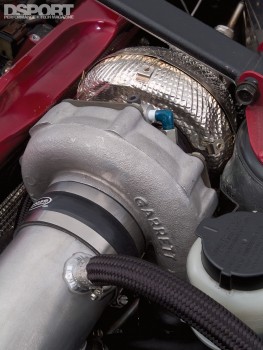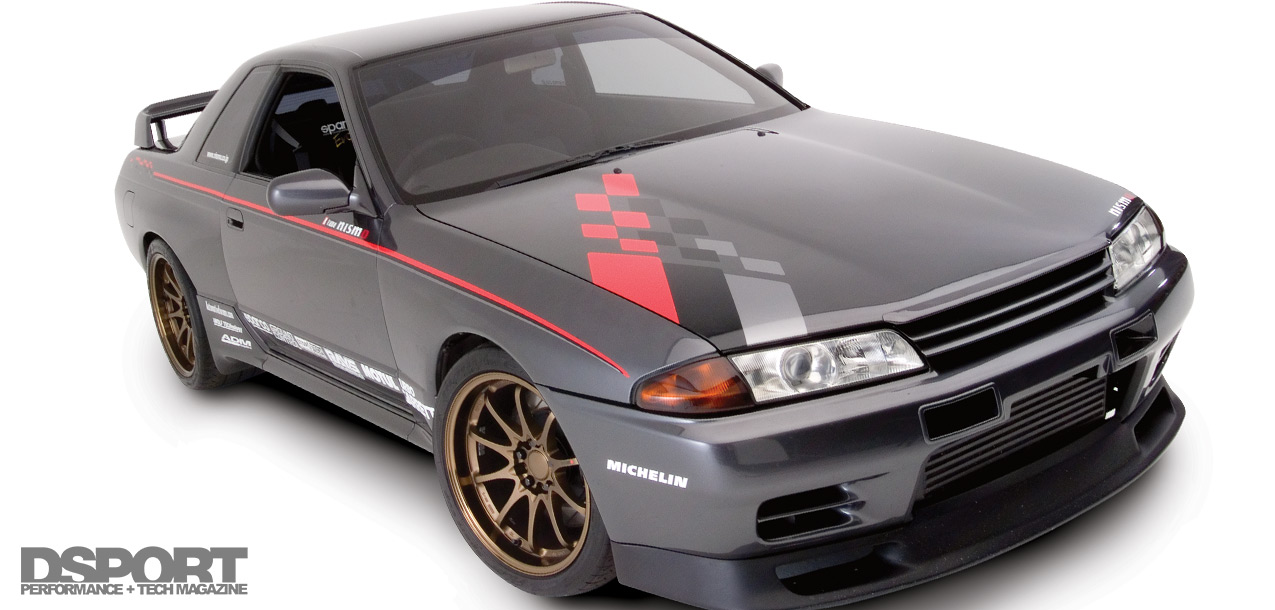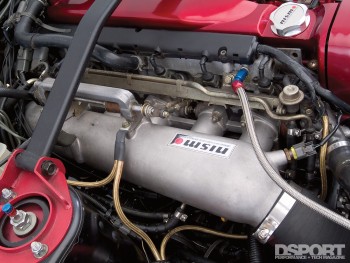It’s a dream that few will realize, but nearly every import-performance enthusiast seems to have. Of course, we are talking about owning your own GT-R. Whether you know about the GT- R from the internet and your favorite magazines or it is just your car of choice on video games, the GT-R has achieved legendary status in the U.S. While online forums may tell you some long tales about how easy it is to register a Skyline GT-R, the reality is that only a small number (about 100 units) are currently legally registered in the United States. Unfortunately, the vehicles currently registered may be the only GT-Rs to legally sport U.S. plates.
Text and Photos by Michael Ferrara
The R32 GT-R
The golden age of the GT-R began with the release of the Nissan Skyline GT-R in 1989. Nissan’s electronically- controlled all-wheel-drive combined with a “detuned” twin-turbo, 2.6-liter RB engine (280 horsepower) for quarter-mile performance in the 13.20 range. While the GT-R was impressive in a straight line, the car truly shined whenever it was pitched into a turn or asked to stop on a dime.
In Japan, it didn’t take long for the GT-R to become the Supercar of choice for tuners. With basic bolt ons such as exhaust, boost controller, ROM tune and intake, generating over 400 flywheel horsepower (over 340 horsepower at the wheels) was an easy task. For those looking for more power, the RB26DETTs in-line six- cylinder foundation provided a capable platform that was ready, willing and able to deliver more power.
Nismo USA R32
In December of 2000, Steve Mitchell purchased his 1992 Skyline GT-R (R32) from Motorex. The car’s first mission would be to prepare for the 2001 SEMA show for the launch of Nismo USA. Nismo Japan flew over the parts and the technicians to get this R32 in “S-tune” trim. A Nismo S- tune suspension was teamed with a Nismo downpipe, Nismo cat-back exhaust, Nismo two-way LSD, Nismo strut tower braces and Nismo 17-inch LMGT4 wheels. This setup made no sacrifices for streetability but added a significant amount of performance.
Steve’s passion for performance would put his focus on improving this GT-R’s ability to tear up the track. In stock trim, his R32 ran a best of one minute, 38 seconds on the Streets of Willow Springs road course. Maximizing performance of a vehicle on a road course requires that attention is paid not only to the engine, but also to the suspension and braking systems of the vehicle.
The Engine
In any project vehicle buildup, it’s not only important to purchase the right parts, it is also important to install these parts in the correct order. For instance, putting on a turbo that has the airflow potential to make 700 horsepower without having a fuel system up to the task of supplying the proper amount of fuel can have catastrophic results. Steve’s quest for additional performance has been guided by the talents of Jim Wolf Technology (JWT) based in San Diego, California. JWT has been responsible for the custom ROM-tuning of the ECU.
 Since the factory turbochargers, Mass Air Flow (MAF) sensors and injectors become maxed out around the 400 horsepower mark, aftermarket solutions would be necessary to take performance to the next level. While turbocharger options for the RB26DETT seem endless, Steve narrowed the field by focusing on single-turbo solutions. The reasoning was simple. Single-turbo offerings would weigh less, cost less and be much less complicated than an aftermarket twin setup. After looking at the available single-turbo options, a decision was made to use the HKS T04R single turbo kit. This kit features a stainless-steel, tubular manifold, T04R turbocharger, HKS 60mm racing wastegate and downpipe. HKS developed this “medium power” kit to generate 670 horsepower at 1.7 bar of boost pressure. With this kit overcoming the shortcomings of the is adequate for normal street driving, a few hard turns on a road course may lead to oil pump starvation. To eliminate any possibility of oil system failures, Steve went to great lengths to improve upon the Nissan wet- sump design. Starting at the pump, an N1 oil pump was chosen to replace the original pump. The N1 oil pump supplies a higher volume of oil through the system. The pump uses an extended GReddy pickup that positions the screen in the GReddy deep sump. A modified Nismo baffle plate uses a series of trap doors to keep the oil where it needs to be under hard acceleration cornering or braking. A pair of Setrab oil coolers (one in right fender, one in left fender) help to keep oil temperatures to a minimum, while a two-quart Accusump provides a final line of defense. A supply of 11 quarts of 15w-50 Motul 300V oil is the lubricant of choice for the “overkill” lubrication system.
Since the factory turbochargers, Mass Air Flow (MAF) sensors and injectors become maxed out around the 400 horsepower mark, aftermarket solutions would be necessary to take performance to the next level. While turbocharger options for the RB26DETT seem endless, Steve narrowed the field by focusing on single-turbo solutions. The reasoning was simple. Single-turbo offerings would weigh less, cost less and be much less complicated than an aftermarket twin setup. After looking at the available single-turbo options, a decision was made to use the HKS T04R single turbo kit. This kit features a stainless-steel, tubular manifold, T04R turbocharger, HKS 60mm racing wastegate and downpipe. HKS developed this “medium power” kit to generate 670 horsepower at 1.7 bar of boost pressure. With this kit overcoming the shortcomings of the is adequate for normal street driving, a few hard turns on a road course may lead to oil pump starvation. To eliminate any possibility of oil system failures, Steve went to great lengths to improve upon the Nissan wet- sump design. Starting at the pump, an N1 oil pump was chosen to replace the original pump. The N1 oil pump supplies a higher volume of oil through the system. The pump uses an extended GReddy pickup that positions the screen in the GReddy deep sump. A modified Nismo baffle plate uses a series of trap doors to keep the oil where it needs to be under hard acceleration cornering or braking. A pair of Setrab oil coolers (one in right fender, one in left fender) help to keep oil temperatures to a minimum, while a two-quart Accusump provides a final line of defense. A supply of 11 quarts of 15w-50 Motul 300V oil is the lubricant of choice for the “overkill” lubrication system.
After a couple of sessions on the dyno and a few outings at the track, Steve found that the T04R turbo was a bit lazier than expected with his current boost and engine combination. With the boost set to a peak of 16psi, 15 psi would be realized at 5600rpm. Since Steve didn’t want to push the engine too far past 8000 rpm, the powerband was somewhat narrower than ideal for a road race vehicle. With the 2.8-liter short block that is planned for the future, the T04R may end up being the perfect complement.  With the 2.6- liter engine in place, Steve decided to try out a GT40R to see if the power band could be expanded. As it turned out, the GT40R was able to reach 15psi as early as 5200rpm. While an increase of 400rpm of powerband may not sound like a lot, it can be the difference between pulling strong and barely pulling after a gear change. With the T04R in place, JWT has optimized the tuning on 91-octane to deliver 533 horsepower at just 16psi of boost pressure as measured on a Dynapack Evolution wheel dyno.
With the 2.6- liter engine in place, Steve decided to try out a GT40R to see if the power band could be expanded. As it turned out, the GT40R was able to reach 15psi as early as 5200rpm. While an increase of 400rpm of powerband may not sound like a lot, it can be the difference between pulling strong and barely pulling after a gear change. With the T04R in place, JWT has optimized the tuning on 91-octane to deliver 533 horsepower at just 16psi of boost pressure as measured on a Dynapack Evolution wheel dyno.





